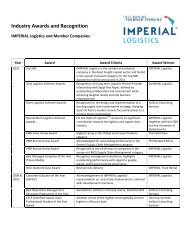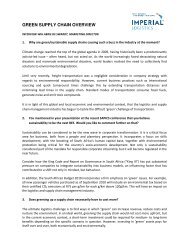HOW CISCO SUCCEEDS A - IMPERIAL Logistics
HOW CISCO SUCCEEDS A - IMPERIAL Logistics
HOW CISCO SUCCEEDS A - IMPERIAL Logistics
Create successful ePaper yourself
Turn your PDF publications into a flip-book with our unique Google optimized e-Paper software.
Risk Management<br />
cessing equipment. These proactive mitigation solutions<br />
and recovery plans became useful during the Chengdu<br />
earthquake. They allowed Cisco to leverage alternate<br />
transportation solutions, offer additional transportation<br />
capacity, and expedite capabilities to the impacted suppliers<br />
in the region.<br />
The Silver Lining to Disruptions<br />
Disruptions provide a unique opportunity to enhance<br />
your capabilities. While the core mission of any supply<br />
chain risk management program is to mitigate disruptions<br />
(if not avoid them altogether), there is a silver lining to<br />
even the most unfortunate occurrences. Process development,<br />
mitigation programs, and even drills will only<br />
tell you so much about your supply chain’s readiness and<br />
responsiveness in the case of a disruption. The true test<br />
of supply chain resiliency comes in the face of events like<br />
the Chengdu earthquake. Even the most thoughtful and<br />
thorough crisis management program will not anticipate<br />
every aspect of a disruption. Moreover, disruptions tend<br />
to be idiosyncratic in nature—each taking on dimensions<br />
and requiring a different response tailored to that<br />
event. In the face of real disruptions, however, organizations<br />
are presented with unique opportunities to refine<br />
their programs.<br />
When events do occur, it becomes<br />
clear very quickly whether your program<br />
has had the right focus and can respond with<br />
the required resiliency.<br />
In the case of the Chengdu earthquake, Cisco<br />
learned several things about its own program and made<br />
appropriate changes. As a result of the event, Cisco<br />
revised the membership of its crisis management teams<br />
to include key external players like manufacturing and<br />
logistics partners and adjusted the activation process.<br />
The company also made its risk management playbooks<br />
and trigger points more forward looking and proactive<br />
based on the type of event. More importantly perhaps,<br />
we gained a fuller appreciation of the importance of having<br />
a closed-loop post-mortem process that allows the<br />
team to capture key lessons and evolve the program.<br />
Cisco understands that a program will never be “baked,”<br />
but rather must be capable of incorporating useful learnings<br />
from new experiences.<br />
Events also play an important role in ensuring<br />
ongoing senior management support, which as we discuss<br />
below is essential to a program’s success. When<br />
events do occur, it becomes clear very quickly whether<br />
your program has had the right focus and can respond<br />
with the required resiliency. Provided that it can (if it<br />
can’t, we recommend your risk manager gets his or her<br />
resume in order), the event provides an opportunity to<br />
move beyond a theoretical value proposition and demonstrate<br />
the program’s real benefits. By creating a historical<br />
log of events and the benefits realized (and pain<br />
avoided) from the risk management program, the SCRM<br />
gains important business intelligence that is particularly<br />
valuable during the planning cycle. Moreover, this does<br />
not need to be a complicated process or calculation. By<br />
understanding the improvement in recovery time resulting<br />
from the program, you can very easily track avoided<br />
impacts to revenue, on-time shipment, and other critical<br />
business metrics.<br />
Securing Senior Management Support<br />
A SCRM program cannot function in a vacuum; it needs<br />
to be a top priority at the highest level and across the<br />
organization. Further, effective SCRM requires coordination<br />
across a wide range of corporate functions.<br />
Despite the overwhelming presence of persistent risk in<br />
supply chains, however, only 12 percent of companies<br />
report having a risk-resilient global supply<br />
chain, according to a survey conducted<br />
by the Aberdeen Group. 2<br />
Support for Cisco’s program comes<br />
from the very top. CEO John Chambers<br />
and Angel Mendez, SVP of the Customer<br />
Value Chain Management organization,<br />
are staunch supporters and maintain<br />
an active role in promoting and driving<br />
ongoing attention to supply chain resiliency. Chambers<br />
is briefed quarterly and sees SCRM as an integral part<br />
of the corporation’s risk profile. Mendez, too, has great<br />
passion around SCRM and has often found himself in<br />
areas where a crisis is going to develop. For example, he<br />
was in Hong Kong in the midst of severe typhoons last<br />
year. When the H1N1 flu virus broke out, guess where<br />
he was? In Mexico City, as part of a Cisco delegation<br />
meeting with the Mexican president!<br />
For Cisco, events like 9/11 and Hurricane Katrina<br />
were catalysts. Even though these events did not significantly<br />
impact Cisco, senior management saw the<br />
potential for disruption resulting from supply chain<br />
issues. Thus, the SCRM team was formed to proactively<br />
put in place infrastructure, processes, programs<br />
and tools to prevent, thwart and recover quickly from a<br />
major disruption.<br />
16 Supply Chain Management Review · July/August 2009 www.scmr.com

















